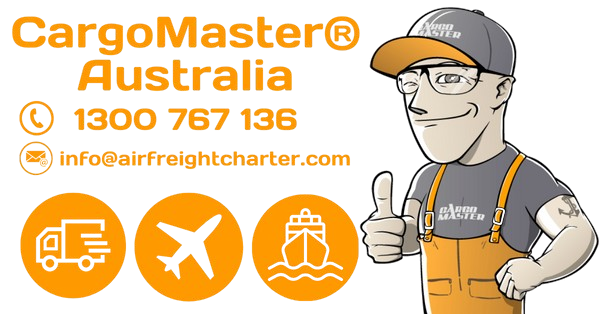Air Freight Charter | Fast, Flexible, & Reliable Solutions
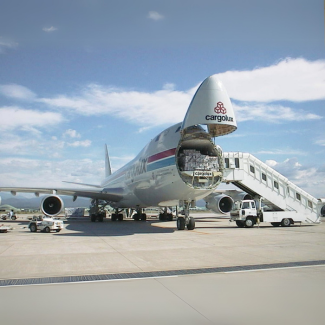 When urgency is non-negotiable, and your cargo demands immediate attention, CargoMaster’s Air Freight Charter services provide the perfect solution for all your shipping needs. Whether you’re transporting critical medical supplies, time-sensitive documents, or oversized industrial machinery, our tailored solutions are designed to meet your unique requirements. With decades of expertise in logistics and a robust network of global partners, we pride ourselves on being the trusted choice for businesses and individuals worldwide. Our team’s unparalleled commitment to excellence ensures that your cargo is handled with the utmost care and professionalism, regardless of its size or destination.
When urgency is non-negotiable, and your cargo demands immediate attention, CargoMaster’s Air Freight Charter services provide the perfect solution for all your shipping needs. Whether you’re transporting critical medical supplies, time-sensitive documents, or oversized industrial machinery, our tailored solutions are designed to meet your unique requirements. With decades of expertise in logistics and a robust network of global partners, we pride ourselves on being the trusted choice for businesses and individuals worldwide. Our team’s unparalleled commitment to excellence ensures that your cargo is handled with the utmost care and professionalism, regardless of its size or destination.
Available around the clock, our air charter services are built to accommodate even the most challenging logistics scenarios. From responding to last-minute emergencies to planning complex shipments, we’re here to deliver when it matters most. Our flexible approach allows us to cater to a diverse range of industries, including mining, healthcare, construction, and entertainment. Whether shipping within Australia or to remote international locations, CargoMaster’s air freight charters guarantee speed and reliability, giving you peace of mind that your goods will reach their destination on time.
At CargoMaster, we understand that time is critical in today’s fast-paced world. That’s why we leverage cutting-edge technology and a global network of aircraft operators to streamline every step of the shipping process. From precise flight planning to comprehensive customs clearance, we ensure that every detail is meticulously managed. Trust CargoMaster to deliver fast, flexible, and reliable solutions for your air freight charter needs, helping you stay ahead in an increasingly competitive market.
Tailored Air Freight Charter for Diverse Needs
 CargoMaster understands that no two shipments are the same. Whether it’s transporting high-value electronics, medical equipment, or oversized machinery, our air freight charters are tailored to meet your unique requirements. Our team works closely with you to develop a customized solution, considering every detail, including the type of cargo, destination, and urgency of delivery.
CargoMaster understands that no two shipments are the same. Whether it’s transporting high-value electronics, medical equipment, or oversized machinery, our air freight charters are tailored to meet your unique requirements. Our team works closely with you to develop a customized solution, considering every detail, including the type of cargo, destination, and urgency of delivery.
Our services extend beyond the ordinary, offering bespoke solutions for industries such as mining, construction, entertainment, and government. We’ve successfully partnered with Australian Defence Forces, touring bands, and humanitarian organizations, delivering everything from critical supplies to large-scale event logistics. By choosing CargoMaster, you’re choosing a partner that prioritizes precision, efficiency, and safety for every shipment.
With access to a global fleet of aircraft and a dedicated team of professionals, we ensure your cargo is handled with care and expertise. From flight permits to ground handling and customs clearance, we oversee every aspect of the process, giving you peace of mind and the assurance of seamless delivery.
Nationwide and Global Coverage
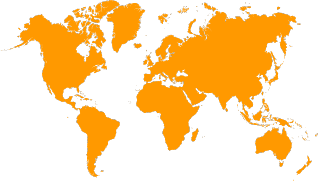 CargoMaster’s Air Freight Charter services cover a wide range of destinations, both within Australia and internationally. From bustling hubs like Sydney, Melbourne, Brisbane, Perth, and Adelaide to remote regional areas, our domestic network ensures your cargo reaches even the most challenging locations.
CargoMaster’s Air Freight Charter services cover a wide range of destinations, both within Australia and internationally. From bustling hubs like Sydney, Melbourne, Brisbane, Perth, and Adelaide to remote regional areas, our domestic network ensures your cargo reaches even the most challenging locations.
For international shipments, our expertise spans the globe, connecting you to destinations across the Pacific Islands, Asia, the Middle East, Europe, and North America. Whether delivering spare parts to a mining site in Australia or coordinating humanitarian aid to remote communities, we leverage our global reach and local expertise to provide timely and reliable solutions.
Our 24/7 availability ensures we’re ready to respond whenever you need us, regardless of time zones or operational constraints. CargoMaster’s commitment to flexibility and accessibility guarantees that your logistics requirements are met promptly and professionally, no matter where your cargo needs to go.
Comprehensive Logistics Management
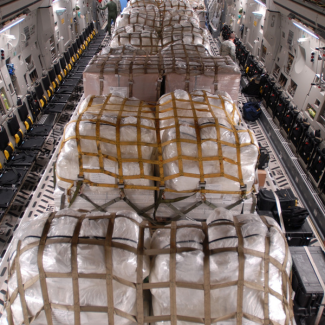 At CargoMaster, we understand the complexities of air freight logistics and aim to transform challenges into seamless solutions for our clients. Every aspect of your shipment, from the initial consultation to the final delivery, is meticulously managed by our experienced team. We take care of essential elements such as precise flight planning, expert cargo packaging, and strict compliance with aviation and customs regulations, ensuring your goods are transported securely and efficiently. Our advanced tracking systems provide real-time updates, giving you full visibility and control over your shipment at every stage of its journey.
At CargoMaster, we understand the complexities of air freight logistics and aim to transform challenges into seamless solutions for our clients. Every aspect of your shipment, from the initial consultation to the final delivery, is meticulously managed by our experienced team. We take care of essential elements such as precise flight planning, expert cargo packaging, and strict compliance with aviation and customs regulations, ensuring your goods are transported securely and efficiently. Our advanced tracking systems provide real-time updates, giving you full visibility and control over your shipment at every stage of its journey.
Our commitment to simplifying the process goes beyond logistics. We believe in empowering our clients with the tools and knowledge they need for a worry-free shipping experience. Whether it’s navigating complex regulatory requirements, identifying cost-saving opportunities, or selecting the best transport route, CargoMaster is your partner in finding solutions tailored to your unique needs. By taking care of the details, we allow you to focus on what matters most—your business and personal priorities.
What truly sets CargoMaster apart is our customer-centric approach. We pride ourselves on providing personalized support and maintaining clear, open communication throughout the process. From addressing last-minute changes to proactively resolving potential challenges, our team is dedicated to exceeding your expectations. Whether it’s a critical delivery that demands urgency or a complex, large-scale project requiring detailed coordination, CargoMaster is committed to delivering an exceptional experience that combines efficiency, reliability, and trust. Let us handle the complexities so you can enjoy peace of mind with every shipment.
Why Choose CargoMaster for Air Freight Charter?
-
Unmatched Expertise: With decades of experience, CargoMaster is a trusted name in air freight logistics.
-
Global Network: Our partnerships with leading aircraft operators and logistics providers enable us to deliver anywhere in the world.
-
Customized Solutions: We tailor our services to meet the specific requirements of your cargo, timeline, and budget.
-
24/7 Availability: Our team is always on hand to assist, ensuring your logistics needs are met promptly and efficiently.
-
Advanced Technology: Real-time tracking and state-of-the-art systems provide visibility and peace of mind.
Get in Touch with CargoMaster Today
Ready to streamline your logistics and ensure your cargo is delivered on time, every time? Contact CargoMaster today and discover how our Air Freight Charter services can revolutionize your shipping experience. Whether managing an urgent delivery or coordinating a complex project, our team of experts is here to provide a solution that exceeds your expectations.
Call 1300 767 136 now to discuss your requirements and receive a tailored quote. With CargoMaster, you’re not just shipping cargo—you’re partnering with a trusted leader in logistics, dedicated to delivering excellence with every shipment.
Let CargoMaster handle your air freight charters with the professionalism and precision you deserve. Explore our services and experience why businesses worldwide choose us for their most critical shipments.
Addition Information Types of Unit Load Devices Used in Australia AKE Container P1P_PAG Pallet Unit Load Devices (ULD) As of January 2023, over one million Unit Load Devices (ULDs) are in use globally. A ULD can take the form of an aircraft pallet, a pallet/net combination, or an aircraft container. These devices are considered removable parts of an aircraft and are regulated by civil aviation authorities. To be deemed airworthy, a ULD must be structurally sound, capable of restraining cargo, and designed to protect both the aircraft’s systems and structure during flight. ULDs undergo regular testing to ensure they meet strict aviation authority standards. This rigorous process ensures that they continue to comply with design and safety regulations. What sets ULDs apart from other aircraft components is that they are the only parts that can be removed and returned to the aircraft after handling by unregulated operators. Despite this, ULDs play a crucial role in flight safety by securing cargo and maintaining aircraft integrity during transit. The international community has established a classification system for easy identification of dangerous goods. These goods fall into nine primary classes, and some classes are further divided to address specific risks. Each class/division has a corresponding label that accurately represents the nature of the hazard. These labels must be attached to the package during transport and remain intact throughout the journey. Take a look at the illustrated examples below to understand how these labels effectively communicate the potential dangers. Under regulations, labels must be clearly visible on the outside of the package and must stay on the package while in transit. You can often find labels printed on most inner packages such as: Below are the 9 hazard labels for the 9 classes of dangerous goods. This includes items such as: These can be transported as: This includes aerosols. Class 2 has 3 divisions: This includes liquids with a boiling point of 35⁰ C or less, or a flash point of 60⁰ C or less such as: These are substances that can spontaneously combust and substances, that when they come into contact with water or emit flammable gases. Class 4 has 3 divisions: These substances are not necessarily combustible on their own but can react dangerously with other substances. Class 5 has 2 divisions: These substances can cause sickness, injury or death if consumed. Class 6 has 2 divisions: These are substances that emit invisible ionising radiation that can be harmful to humans and animals. It can cause objects such as aircraft and equipment to become contaminated if not packaged and handled correctly, such as: These substances can cause irreversible damage if they come into contact with skin and could destroy other freight, or materially damage containers or aircraft. This includes: These are substances and articles which, during air transport, present a danger not covered by other classes. There are 2 types of handling labels – 1 for lithium battery shipments, and another for all other miscellaneous dangerous goods. This class includes: In addition to hazard labels, trained staff must attach handling labels where needed. Staff must use these 4 handling labels with the appropriate hazard labels: This label is used to show that the load cannot be carried on a passenger aircraft. This label is used on liquefied gases, such as the ones in Class 2. This label ensures a load is placed the correct way up and can be used for non-dangerous goods. This label ensures that the load is kept away from the aircraft compass detector unit while being loaded and unloaded. AIRPORTS NEW SOUTH WALES (NSW) INCOTERMS are standard trade terms most commonly used in international freight contracts for sale of goods. It is essential that you are aware of your terms of trade prior to shipment. EXW – EX WORKS (… named place of delivery) FCA – FREE CARRIER (… named place of delivery) CPT – CARRIAGE PAID TO (… named place of destination) CIP– CARRIAGE AND INSURANCE PAID TO (… named place of destination) DAT – DELIVERED AT TERMINAL (… named terminal at port or place of destination) DAP – DELIVERED AT PLACE (… named place of destination) DDP – DELIVERED DUTY PAID (… named place) MARITIME TERMS FAS – FREE ALONGSIDE SHIP (… named port of shipment) FOB– FREE ON BOARD (… named port of shipment) CFR– COST AND FREIGHT (… named port of destination) CIF – COST INSURANCE AND FREIGHT (… named port of destination) Why is it crucial to verify Bill of Lading details? When is the Bill of Lading Issued? How is the Bill of Lading Compiled? A Contract in Documentation: The Bill of Lading Insight into the Documentation Timeline Certificate of Free Sale (CFS) When exporting to certain countries you will require a Certificate of Free Sale (CFS), also called an export certificate or certificate of export. An Export Certificate confirms in writing that you can sell your goods in the Australian market and that there are no restrictions. The Certificate of Free Sale certifies that you have the approval of relevant authorities to sell your goods in Australia. The overseas purchaser of your products may have problems with customs clearance and registration process’s if you do not provide a CFS when required, your buyer may not be able to import your product into their country. You may need to present this certificate as part of the customs clearance or registration process. A CFS is often requested for products such as: Not all countries require a CFS, the need for a Certificate of Free Sale will depend on your product and your export market. Speak with your buyer to find out if you need a CFS. Where can I get a Certificate of Free Sale? To find out more and apply for a Certificate of Free Sale (CFS) visit: ATA Carnet (Admission Temporary Admission) An ATA Carnet is an international document that permits temporary the temporary entry of commodities into overseas countries. Carnets are used for goods that are intended to be imported for a short period of time, then exported back to the country of origin. It provides exemptions for import duties and taxes. It is most often used for high-value goods imported for specific uses. Typical goods that may be transported under a Carnet: To apply for a Carnet contact The Australian Chamber Of Commerce and Industry Australian Chamber of Commerce and Industry www.australianchamber.com.au/international/certificates-of-origin (ACCI). Phytosanitary Certificate Certificate of Origin (CoO) Note: Always check specific product and market requirements for accurate documentation needs. Certificates of Origin are needed when Origin when Some agreements will allow for a self-certification, while others require a certificate from an authorised body. Self-certification carries a high level of risk and is not recommended for new exporters. There are 2 types of Certificates of Origin A Preferential certificate will assist customs authorities to confirm your compliance with trade agreements made, tariffs and and Rules of Origin. Rules of Origin (ROO) are an agreed set of rules between countries that share a preferential trade agreement, such as a Free Trade Agreement (FTA). ROO set out the criteria for which goods are eligible for free or preferential import tariffs. Typically, they require a product to be entirely produced in a one of the participating countries or have a minimum percentage of the value produced there. They can be complex to understand so speak with your customs broker or freight forwarder or visit the DFAT Free Trade Agreement Portal. Note: If Australia has a Free Trade Agreement (FTA) with the country you are exporting to you can apply for a Preferential certificate 2. Non-preferential certificates Local governments of most countries issue non-preferential certificates to collect statistical data and ensure you are meeting: Where can I get a Certificate of Origin? To find out more and apply for a Certificate of Origin (COO) visit: For information about the documents needed for specific products check out. CargoMaster ensures a seamless freight experience, combining expertise, accuracy, and compliance for precise cargo transport. Call us at 1300 767 136 for tailored shipping solutions and competitive rates.
(Click the +/- plus/minus symbols to expand/collapse) IATA CODES FOR MAJOR AUSTRALIAN AIRPORTS
Airport IATA code ICAO code Adelaide ADL YPAD Alice Springs ASP YBAS Brisbane BNE YBBN Cairns CNS YBCS Canberra CBR YSCB Darwin DRW YPDN Gold Coast OOL YBCG Hobart HBA YMHB Launceston LST YMLT Melbourne (Avalon) AVV YMAV Melbourne (Tullamarine) MEL YMML Perth PER YPPH Sunshine Coast MCY YBSU Sydney SYD YSSY Townsville TSV YBTL INTERNATIONAL AIRPORTS
City Country Airport code Albany US ALB Albuquerque US ABQ Anguilla Anguilla AXA Antigua Antigua and Barbuda ANU Antofagasta Chile ANF Arica Chile ARI Aruba Aruba AUA Asuncion Paraguay ASU Atlanta US ATL Austin US AUS Baltimore US BWI Barcelona Venezuela BLA Baton Rouge US BTR Belize City Belize BZE Belo Horizonte Brazil CNF Birmingham US BHM Bogota Colombia BOG Bristol US TRI Buenos Aires Argentina BUE/EZE Buffalo US BUF Burlington US BRL Calgary Canada YYC Cancun Mexico CUN Cap Haitien Haiti CAP Caracas Venezuela CCS Cedar Rapids US CID Charleston US CHS Charlotte US CLT Chicago US ORD Cincinnati US CVG Cleveland US CLE Columbia US CAE Columbus US CMH Cordoba Argentina COR Corpus Christi US CRP Curacao Antilles CUR Curitiba Brazil CWB Dallas US DFW Dayton US DAY Denver US DEN Des Moines US DSM Detroit US DTW Dominica Dominica DOM El Paso US ELP Fort Da France Martinique FDF Freeport Bahamas FPO Georgetown Guyana GEO Grand Cayman Cayman Islands GCM Greensboro US GSO Greenville US GSP Grenada Grenada GND Guadalajara Mexico GDL Guatemala City Guatemala GUA Guayaquil Ecuador GYE Harrisburg US MDT Hartford US BDL Houston US IAH Huntsville US HSV Indianapolis US IND Iquique Chile IQQ Jackson US JAN Jacksonville US JAX Kansas City US MCI Knoxville US TYS Lafayette US LFT Laredo US LRD Lima Peru LIM Little Rock US LIT Louisville US SDF Manaus Brazil MAO Maracaibo Venezuela MAR Mcallen US MFE Medellin Colombia MDE Memphis US MEM Mendoza Argentina MDZ Merida Mexico MID Mexico City Mexico MEX Miami US MIA Milwaukee US MKE Minneapolis US MSP Mobile US MOB Moline US MLI Monterrey Mexico MTY Montevideo Uruguay MVD Montreal Canada YUL Nashville US BNA Nassau Bahamas NAS Nevis St Kitts and Nevis NEV New Orleans US MSY Newburgh US SWF Norfolk US ORF Oak Harbor US ODW Oklahoma City US OKC Omaha US OMA Ottawa Canada YOW Panama City Panama PTY Pensacola US PNS Philadelphia US PHL Phoenix US PHX Pittsburgh US PIT Pointe-A-Pitre Guadaloupe PTP Porlamar Venezuela PMV Port Au Prince Haiti PAP Port of Spain Trinidad POS Portland US PDX Porto Alegre Brazil POA Providenciales Turks & Caicos PLS Puerto Plata Dominican Republic POP Punta Arenas Chile PUQ Quito Ecuador UIO Raleigh Durham US RDU Richmond US RIC Rio De Janairo Brazil RIO Rochester US ROC Sacramento US SMF Salt Lake City US SLC San Antonio US SAT San Diego US SAN San Jose Costa Rica SJO San Juan Puerto Rico SJU San Luis Potosi Mexico SLP San Pedro Sula Honduras SAP San Salvador El Salvador SAL Santiago Chile SCL Santiago Dominican Republic STI Santo Domingo Dominican Republic SDQ Sao Paulo Brazil GRU Seattle US SEA St Croix US Virgin Islands STX St Kitts St Kitts SKB St Louis US STL St Lucia St Lucia UVF St Maarten St Maarten SXM St Thomas Virgin Islands STT St Vincent St Vincent SVD Syracuse US SYR Tampa US TPA Tegucigalpa Honduras TGU Tobago Tobago TAB Toledo US TOL Toronto Canada YYZ Tortola Virgin Islands EIS Tucson US TUS Tulsa US TUL Valencia Venezuela VLN Vancouver Canada YVR Viracopos Brazil VCP Vitoria Brazil VIX Wilmington US ILM Adelaide Australia ADL Ahmedabad India AMD Auckland New Zealand AKL Bagram Afghanistan OAI Bangalore India BLR Bangkok Thailand BKK Beijing China PEK Brisbane Australia BNE Cairns Australia CNS Canberra Australia CBR Changchun China CGQ Changsha China CSX Chengdu China CTU Chennai India MAA Chongquing China CKG Christchurch New Zealand CHC Colombo Sri Lanka CMB Dalian China DLC Dhaka Bangladesh DAC Dongguan China DGM Fuzhou China FOC Gold Coast Australia OOL Guangzhou China CAN Guilin China KWL Hangzhou China HGH Harbin China HRB Hefei China HFE City Country Aiport code Aberdeen UK ABZ Abu Dhabi UAE AUH Addis Ababa Ethiopia ADD Alicante Spain ALC Almaty Kazakhstan ALA Almeria Spain LEI Amman Jordan AMM Amsterdam Netherlands AMS Antalya Turkey AYT Antwerp Belgium ANR Arrecife/Lanzarote Spain ACE Baghdad Iraq BGW Bahrain Bahrain BAH Baku Azerbaijan BAK Balad Iraq XQC Barcelona Spain BCN Basel Switzerland BSL Beirut Lebanon BEY Belfast UK BFS Bergen Norway BGO Berlin Germany BER Billund Denmark BLL Birmingham UK BHX Bishkek Kyrgyzstan FRU Bordeaux France BOD Bournemouth UK BOH Bratislava Slovakia BTS Bremen Germany BRE Bristol UK BRS Brussels Belgium BRU Bucharest Romania OTP Budapest Hungary BUD Cairo Egypt CAI Cardiff UK CWL Cologne Germany CGN Copenhagen Denmark CPH Cork Ireland ORK Dalaman Turkey DLM Damascus Syria DAM Dammam Saudi Arabia DMM Dar Es Salaam Tanzania DAR Doha Qatar DOH Dublin Ireland DUB Durban South Africa DUR Dusseldorf Germany DUS East Midlands UK EMA Edinburgh UK EDI Entebbe Uganda EBB Erbil Iraq EBL Exeter UK EXT Frankfurt Germany FRA Fuerteventura Spain FUE Geneva Switzerland GVA Gibraltar Gibraltar GIB Glasgow UK GLA Gothenburg Sweden GOT Guernsey Channel Islands GCI Hamburg Germany HAM Hanover Germany HAJ Helsinki Finland HEL Humberside UK HUY Ibiza Spain IBZ Inverness UK INV Isle of Man UK IOM Istanbul Turkey IST Jeddah Saudi Arabia JED Jersey Channel Islands JER Juba Sudan JUB Kigali Rwanda KGL Kuwait Kuwait KWI Larnaca Cyprus LCA Las Palmas Spain LPA Leeds Bradford UK LBA Leipzig Germany LEJ Lille France LIL Liverpool UK LPL Ljubljana Slovenia LJU Luxembourg Luxembourg LUX Lyons France LYS Madrid Spain MAD Malaga Spain AGP Malmo Sweden MMA Malta Malta MLA Manchester UK MAN Marseilles France MRS Mauritius Republic of Mauritius MRU Menorca Spain MAH Milan Italy MIL Mombasa Kenya MBA Moscow Russia SVO/DME Munich Germany MUC Murcia Spain MJV Muscat Oman MCT Mwanza Tanzania MWZ Nantes France NTE Newcastle UK NCL Norwich UK NWI Nuremburg Germany NUE Oslo Norway OSL Ostend Belgium OST Palma Mallorca Spain PMI Paris France CDG Port Elizabeth South Africa PLZ Prague Czech Republic PRG Prestwick UK PIK Pristina Kosovo PRN Reus Spain REU Riyadh Saudi Arabia RUH Rotterdam Netherlands RTM Sana'a Yemen SAH Sarajevo Bosnia and Herzegovina SJJ Seychelles Republic of Seychelles SEZ Shannon Ireland SNN Sharjah UAE SHJ Skopje Macedonia SKP Sofia Bulgaria SOF Southampton UK SOU St Petersburg Russia LED Stavanger Norway SVG Stockholm Sweden STO Strasbourg France SXB Stuttgart Germany STR Tblisi Georgia TBS Tehran Iran THR Tenerife Spain TFS Tirana Albania TIA Toulouse France TLS Turin Italy TRN Valencia Spain VLC Vienna Austria VIE Vilnius Lithuania VNO Vitoria Spain VIT Warsaw Poland WAW Yerevan Armenia EVN Zurich Switzerland ZRH Kandahar Afghanistan KDH Karachi Pakistan KHI Kolkata India CCU Kuala Lumpur Malaysia KUL Lahore Pakistan LHE Male Maldives MLE Manila Philippines MNL Melbourne Australia MEL Mumbai India BOM Nagoya Japan NGO Nanchang China KHN Nanking China NKG Ningbo China NGB Osaka Japan KIX Perth Australia PER Peshawar Pakistan PEW Phuket Thailand HKT Qingdao China TAO Shenyang China SHE Shenzen China SZX Singapore Singapore SIN Suzhou China SZV Taipei Taiwan TPE Tanegashima Japan TNA Tianjin China TSN Urumqi China URC Wenzhou China WNZ Wuhan China WUH Wuxi China WUX Yantai China YNT Zhengzhou China CGO Zi an China SIA Ziamen China XMN Hobart Australia HBA Huangpu China ZMY Hyderabad India HYD Islamabad Pakistan ISB Jaipur India JAI Jakarta Indonesia JKT Kabul Afghanistan KBL Kaimana Indonesia KMG GLOSSARY OF AIR FREIGHT TERMS AND ABBREVIATIONS
A2A Airport-to-airport A2D Airport-to-door ADV Advise, Advised, Advising AEA Association of European Airlines (see the page “Interest Organisations” of this website also) Airline Company operating aircraft between steady origin and destination airports Airmail Mail travelling by air Air Operator Company operating aircraft Airport-to-airport Transport from an airport of origin to an airport of destination Allotment Assigned volume on board of a flight / day AOG Aircraft On Ground ; materials expedited for repair of a grounded aircraft AP Airport ARR Arrive, Arrived, Arrival ARR Also a C2K milestone: ARR = cargo and documents arrived at airport of destination ATA Air Transport Association (see the page “Interest Organisations” of this website also) ATA Actual Time of Arrival ATD Actual Time of Departure Authorisation The commission to a certain person or body to act on behalf of another person or body ; the person or body can be authorised e.g. to issue air waybills or to collect freight AVI Live Animal(s) AWB Air Waybill Backlog Amount of goods still to be delivered or received and for which the planned or agreed date has expired BAG Baggage Belly Lower-deck cargo hold of an aircraft BIG Outsized cargo Blocked-space agreement A continuous reservation (allotment) for space at one or more flight / date combinations with an airline Bonded Goods Goods on which the customs duty has not yet been paid, and which therefore, are under the control of customs; usually in a Bonded warehouse. Bonded warehouse A depository for goods on which the customs duty has not been paid ; the warehouse proprietor must provide a bond (often in the form of a bank warranty or a mortgage) to the customs authorities as a security for any duties which may not be paid by the customer Booking Request for reservation of space on a flight/day, (to be) confirmed by the airline Break Bulk Agent A forwarder breaking the bulk: taking care of the unpacking and sorting of goods after the flight Breakdown List List of shipments carried in one consolidation (see also: Consolidation Manifest) Broker Person who acts as an agent or intermediary in negotiating contracts ; sometimes refers to a forwarder role Bulk Cargo Loose cargo not loaded on an ULD C2K Cargo 2000 (see the “Cargo 2000” page of this website) Cargo Aircraft Aircraft built with the purpose of carrying nothing else than cargo Cargo assembly The separate reception of parcels or packages and the holding of them for later dispatch as one consignment ; consolidator role Cargo Disassembly The separation of one or more of the parcels or packages that are part of a consignment for further distribution ; break bulk role Carriage Transport ; the process of conveying cargo from one point to another Carrier The party responsible for transport of goods from one point to another, this can be for example an airline or a forwarder (as a NVOCC) CASS Cargo Accounts Settlement System CAO Cargo Aircraft Only CC Charges Collect ; pay at moment of collection of the goods CCS Cargo Community System ; information system integrating the communication between air cargo parties at an airport Certificate of Origin A certificate proving the country of original production of goods ; used for customs declaration purposes Charges collect Charges as stated on the air waybill to be collected from the consignee Charges prepaid Charges as stated on the air waybill to be collected from the shipper Claim A written complaint about the execution of a contract of transportation by a carrier, combined with a demand for financial compensation Classifying Assigning the right import classification number to goods as part of the customs declaration process CLR Clear CNEE Consignee COLL Collect, Collected, Collecting COMAT Company Material (non revenue cargo) Combi Combi Aircraft, combining transport of passengers and cargo on the main-deck Commodity Indication of the type of goods ; commodities are coded according to the harmonised system Commodity code Code used in the Harmonised System for the classification of goods, which are most commonly produced and traded Complaint An official statement from a customer to a carrier about his unhappiness with the service or operation of the service provider Consignee The person or company that is physically and administratively responsible for accepting the goods at final delivery Consolidation A collection of shipments belonging to different shippers travelling to one destination or area to be distributed to several consignees Consolidation Manifest List of shipments carried in one consolidation Consolidation Rates Rates as given by a consolidator / forwarder Consolidator A forwarder consolidating shipments before a flight ; these shipments belonging to different shippers and travelling to one destination or area in order to be distributed to several consignees after the flight Courier Company that carries envelopes and parcels up to 75 kg from door to door ; air transport is generally outsourced to airlines Courier Rates Rates as given by a courier CPTY Capacity CRN Customs Release Note Customs Agent/Broker (Certified) Party certified to handle the customs clearance on account of importers / exporters Customs invoice (Pro forma) Invoice for import declaration (customs and statistics) purposes, stating the commercial price, added with the costs for freight, insurance and packing etc., terms of delivery and payment Customs value Value of goods to be imported for import declaration (customs and statistics) purposes D2A Door-to-airport D2D Door-to-door Dangerous Goods Goods that can be hazardous for health, flight-safety or materials DAP A C2K key performance indicator: DAP = Delivered As Promised (NFD in full and on time statuses are achieved) DEP A C2K milestone: DEP = cargo and documents departed at airport of origin DEPT Department DG Dangerous Goods DGR Dangerous Goods Regulations (IATA) Dimensional Weight (Conversion) Concept adopted by the transportation industry worldwide as a uniform means of establishing a minimum charge for the cubic space a package occupies ; the volume is converted into a (higher) weight / price class DIMS Dimensions DIP Diplomatic mail DLV Deliver, Delivered, Delivering DLV Also a C2K milestone: DLV = cargo and documents delivered to customer (forwarder) DOCS Document(s), Documentation Domestic transport Transport within a country Door-to-door Transport from an initial shipper’s house address to a final consignee’s house address Duty Tax imposed on goods imported from another country EDI Electronic Data Interchange EDIFACT Electronic Data Interchange For Administration, Commerce and Transport ; a specific EDI protocol e-Freight Electronic freight documents project from IATA ; e-Freight aims to take the paper out of the air cargo supply chain and -processes and replace it with cheaper, more accurate and more reliable electronic messaging ; facilitated by IATA, the project is an industry-wide initiative involving carriers, freight forwarders, ground handlers, shippers and customs authorities Electronic Data Interchange The interchange of electronic data, structured following an agreed protocol, between the automated information system of different parties Embargo An embargo on a certain kind of goods means these goods will not be transported by the airline, often for flight-safety reasons Equipment Materials needed to handle or transport goods ESC European Shippers’ Council (see the page “Interest Organisations” of this website also) ETA Estimated Time of Arrival ETD Estimated Time of Departure Expediting Forwarding goods (in less than the normal lead time) Expeditor Forwarder FAK Freight All Kinds FAK-Rates Rates for Freight All Kinds FAP A C2K key performance indicator: FAP = Flown As Planned (the complete shipment has flown at or before the last planned flight with a maximum 12 hour delay) FCL Full Container Load FDCA Found Cargo FFM Freight Forwarding Message (electronic) FIATA International Federation of Freight Forwarders Associations (see the page “Interest Organisations” of this website also) FLT Flight Forwarder Company specialized in providing door-to-airport transport, arranging connecting air transport and/or airport-to-door transport for parcels and consolidations > 75 kg or up to anything that fits in an aircraft ; the air transport is generally outsourced to airlines and sometimes aircraft operators or air charter companies Forwarder network A network existing of different smaller to medium sized forwarding companies all over the world working together Freighter Aircraft built with the purpose of carrying nothing else than cargo FSU Freight Status Update Fuel Surcharge Surcharge added to the cargo rate to cover the additional costs of increasing fuel-prices ; these will generally follow a certain index Full charter Chartering the full available volume of an aircraft or flight/day Full Container Load Container fully loaded, generally with goods belonging to one party Full freighter Aircraft built with the purpose of carrying nothing else than cargo FWB Electronic air waybill message FWB Also a C2K milestone: FWB = the shipment is booked at the airline, next an electronic air waybill is generated by agent (forwarder) ; this creates the so-called route map in C2K in which all the steps are followed FYI For Your Information General Cargo Rates Rates for all different kinds of cargo, not falling into a specific handling and/or rate category GSA General Sales Agent GSF Global Shippers Forum (see the page “Interest Organisations” of this website also) Handling Agent Agent handling the ramp and/or warehouse cargo operation for an airline Harmonised System A numeric multi purpose system for the classification of goods with its six digits covering about 5000 descriptions of the products or groups of products most commonly produced and traded, designed for customs purposes, but can also be used for statistics, transport purposes, export, import and manufacturing; the international convention on the HS was established under auspices of the World Customs Organisation in 1983 Haulage Inland transport of cargo Haulier Road carrier HEA Heavy Cargo HAWB House Air Waybill House Air Waybill The shipment contract between the end-customer and the forwarder (see the page “Forwarding Out” of this website for further purposes and explanation) Hub Central point in a transport system or network HUM Human remains HWB House Waybill IATA International Air Transport Association (see the page “Interest Organisations” of this website also) IATA-Agent An IATA certified agent ICAL Inbound Cargo Action List ICAO International Civil Aviation Organisation (see the page “Interest Organisations” of this website also) ICE Dry Ice Shipment IN Inches Inco terms Internationally agreed set of standard delivery terms Integrator Carrier integrating different modes of transport to form a door-to-door transport or supply chain ; this term mostly refers to the large international express companies who’s core business is to carry envelopes and parcels up to 75 kg, often overnight or even same day Intermodal Transport The movement of cargo in a supply chain by more than one mode of transport ; for example road/air or sea/air transport INV Invoice ISA If Space Available KG Kilos L/C Letter of Credit LCL Less than Container Load Less than Container Load Container partly filled with goods from one party, or an amount of goods that is not sufficient to fill one container and will therefore likely be consolidated LHO Living Human Organs / Blood License, import/export Governmental permit to import / export certain goods under certain conditions Line item Order line, each line on a packing list or invoice to be declared for customs Load factor The extent to which the aircraft (weight-, volume-, ULD-) capacity is efficiently utilized (to generate profit) LOC Location Loose cargo/shipments Cargo / shipments not loaded on an ULD Lower Deck The (cargo) deck below the main deck or upper deck of an aircraft LT Local Time Main deck Upper deck ; the (cargo) deck above the lower deck of an aircraft Manifest, flight Document listing the air waybills and a specification of the related goods carried on a flight Master Air Waybill The shipment contract between the forwarder and the airline (see the page “Forwarding Out” of this website for further purposes and explanation) MAWB Master Air Waybill MFST Manifest Minimum Rate Rate to cover the basic costs of carrying a shipment MSG Message(s) Network Forwarder A large forwarding company with worldwide branches NFD A C2K milestone: NFD = cargo and documents ready for pick-up at airline (handler), the customer (forwarder) is notified NND Notice of Non Delivery NON-IATA Airline or agent that is not a member of IATA Nose loading Loading cargo through the cargo door in the nose of an aircraft Notify address Address of a party other than the consignee to be notified of arrival of the goods Notify party Party other than the consignee to be notified of arrival of the goods NOTOC Notification To Captain ; list for the captain of the aircraft with goods carried on board N-Rates Rates for shipments with weights up to 45 kg NVOCC Non Vessel Operating/Owning Cargo Carrier ; in case of Air Cargo a Carrier (e.g. a Forwarder or Consolidator) who issues Air Waybills for the carriage of cargo on aircraft which he does not operate or own OAG Official Airlines Guide OB On Board Oversized Cargo Cargo that exceeds the dimensions of an ULD Package Packed piece of cargo Packing list A list for customs declaration and consignment purposes stating number and kinds of packages being shipped, totals of gross, legal, and net weights of the packages, marks and numbers on the packages, contents and part-/serialnumbers Pallet A (standardized) platform on which goods can be stacked for transport or warehouse handling purposes Pallet, aircraft A (standardized) platform on which goods can be stacked for air transport purposes Pallet net A net used to secure the cargo on the aircraft pallet Parcel Package Part charter Chartering of a part of the available volume on an aircraft or flight/day Part shipment Part of a shipment that travels on a different flight and/or day than the rest of the shipment due to available capacity with the airline PAX Passenger(s) Payload The (cargo) load that can be carried by an aircraft (to generate revenue) PC Piece(s) PER Perishable Cargo PFI Pro Forma Invoice POA Proof Of Acceptance ; legal proof a shipment has been accepted by a party POD Proof Of Delivery ; legal proof a shipment has been delivered by a party POD Place Of Delivery PP Charges Prepaid PPD Prepaid Pre-alert Message stating the current and or expected status of the goods Principal The customer ordering the transport or related services PSH Part Shipment QNTY Quantity Q-Rates Rates with a quantity discount RCF A C2K milestone: RCF = cargo has arrived in the cargo bay at final destination ; cargo and airwaybill are administratively received in the system RCPT Receipt, Reception RCS A C2K milestone: RCS = cargo and documents are received ‘Ready For Carriage’ and accepted by airline (handler) Ready For Carriage (By Air) The goods are correctly packed and labeled, and customs cleared, with the right documents attached Ready For Transport (By Road) The goods are correctly packed and labeled, with the right documents attached RFC Ready For Carriage RFT Ready For Transport Routing The path that is (to be) followed by the goods from shipper to consignee RUSHR Rush Reply SASPO As Soon As Possible SAWB Substitute Air Waybill Security Surcharge Surcharge added to the cargo rate to cover the additional costs of the increasing number of security checks and related administration that are legally required by the authorities Shipper The person or company that is physically and administratively responsible for shipping the goods ; for an airline in most cases a forwarder will be the shipper, for a forwarder the shipper is a third party, for example a trading company, a manufacturer, etc. Shipper’s Letter of Instruction Document issued by the shipper to instruct and authorize the forwarder to forward and declare goods on his behalf ; contains all shipment details needed to facilitate these services SHPMNT Shipment Side loading Loading cargo through a cargo door in the side of an aircraft Skid Pallet S/L Short Loaded SLI Shipper’s Letter of Instruction SSPD Short Shipped ; stayed behind TACT The Air Cargo Tariff ; publication of official airline tariffs TBA Time Before Arrival TBD Time Before Departure TEMP Temperature TIACA The International Air Cargo Association (see the page “Interest Organisations” of this website also) TILNA Tilting Not Allowed TILTA Tilting Allowed Time Slot The agreed time to collect or deliver goods Tonne Kilometer One tonne (1000 kg or 2204.6 lb) metric flown one kilometer ; productivity indicator TRA Transit Tracing Retrieving (information on) the status of goods and documents Tracking Regular checking on the status of goods and documents Track & Trace Automated regular retrieval of (information on) the status of goods and documents and checking these against the agreed norms Transfer cargo Transfer of cargo from one flight to another Transito / Transit cargo Transfer of cargo from one flight to another TRM Transfer Manifest TTL Total ULD Unit Load Device ULD, contoured Unit Load Device shaped to exactly fit in an aircraft UNACC Unaccompanied Unit Load Device Standardized air cargo loading equipment (pallet, container) Upper deck Main deck ; the (cargo) deck above the lower deck of an aircraft VAL Valuable cargo VAT Value Added Tax VOL Volume Volume charge Air transport charge based on the volume of goods instead of the actual weight (see “Dimensional Weight” and “Weight charge” also) VUN Vulnerable cargo Weight charge Air transport charge based on the actual weight of the goods (see “Dimensional Weight” and “Volume charge” also) Weight & Balance Management of the weight and allocation of cargo, passengers and fuel for a flight W/H Warehouse XPS Priority Small Package XS In Excess Yield management The process of maximising the contribution (revenue) of the (transport & handling) network, equipment, infrastructure and resources UNIT LOAD DEVICES (ULD)
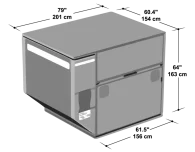 AAU Container
AAU Container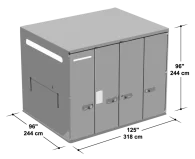 ALF Container
ALF Container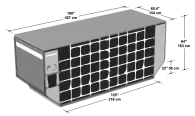 AMA Container
AMA Container AMF Container
AMF Container
(LD),6,033kg (MD)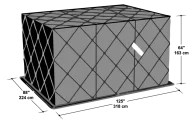 PEB Container
PEB Container
(B-HIH -1,300 KG)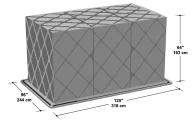 PLA Pallet
PLA Pallet
Loadable Aircraft Type: 747, 747F, 777, Airbus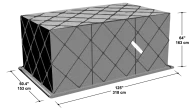 PMC_PQP_P6P Pallet
PMC_PQP_P6P Pallet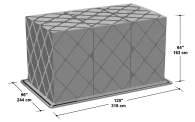 RKN Container
RKN Container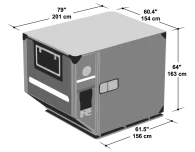 VZA_VRA
VZA_VRA
9,300 kg c(Max Gross Weight of Pallet)
AIR FREIGHT FREIGHTER SPECIFICATIONS
Make/Model Max Payload
TonnesMax Loadable Volume
CBM3Cargo Hold Dims
LxWxH cmCargo Door Size
WxH cmCessna 406 Titan 1.2 6.5 320 x 120 x 117 124 x 116 Fairchild Metroliner II 1.4 12 835 x 115 x 120 130 x 115 Fairchild Metroliner III 2.1 12 775 x 158 x 145 130 x 115 Fairchild Metroliner 23 2.3 18 775 x 158 x 145 127 x 115 Falcon 20 / 200 2.5 11 704 x 156 x 142 190 x 140 Shorts 360 3.5 40 815 x 190 x 190 142 x 168 Saab 340 3.8 40 1300 x 170 x 170 135 x 130 Aerospatiale ATR42 4.6 40 1080 x 225 x 143 125 x 153 Fokker 27 6.3 58 1336 x 210 x 190 228 x 175 Antonov AN-26 6.5 45 1110 x 220 x 160 230 x 171 Antonov AN-74 6.5 45 1000 x 215 x 220 226 x 220 British Aerospace ATP 8.2 78 1500 x 195 x 180 250 x 169 Lockheed L-188 Electra 15 135 2000 x 280 x 220 355 x 203 Boeing 737-300F 16 115 2100 x 310 x 220 340 x 215 Antonov AN-12 18 95 1380 x 300 x 250 300 x 250 Lockheed L-100 Hercules 21 140 1707 x 302 x 274 302 x 274 Boeing 727-200F 23.5 144 2712 x 351 x 218 340 x 218 Boeing 757F 39 187 3327 x 353 x 218 340 x 218 Airbus A300 B4F 40 280 3900 x 477 x 223 358 x 256 Douglas DC8-62 40 200 3400 x 317 x 203 355 x 215 Douglas DC8-54/55 41 180 3100 x 317 x 203 355 x 215 Ilyushin IL-76 45 180 1850 x 345 x 325 344 x 340 Antonov AN-22 50 650 2640 x 430 x 430 430 x 430 Lockheed L10-11 Tristar 55 420 3300 x 360 x 274 431 x 284 Boeing 767-300F 55 400 3000 x 400 x 250 340 x 254 Douglas DC10-30 65 400 3725 x 448 x 245 350 x 245 McDonnell Douglas MD11 85 500 4800 x 350 x 245 355 x 245 Boeing 747-100F 90 675 4800 x 488 x 300 340 x 300 Boeing 747-200F 100 675 4900 x 488 x 300 340 x 300 Boeing 777F 100 625 4400 x 488 x 300 372 x 305 Boeing 747-300/400F 110 675 5000 x 488 x 300 340 x 300 Antonov AN-124 120 800 3650 x 640 x 440 640 x 440 Antonov AN-225 250 1100 4300 x 640 x 440 640 x 440 HAZARD LABELS DANGEROUS GOODS (DG)
Hazard Labels for
Dangerous Goods (DG)Class 1 Explosives

Class 2 Gases

Class 3 Flammable liquids

Class 4 Flammable solids

Class 5 Oxidising substances and organic peroxides

Class 6 Toxic and infectious substances

Class 7 Radioactive materials

Class 8 Corrosives

Class 9 Miscellaneous
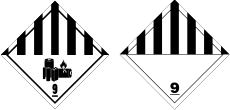
Handling labels
Cargo aircraft only

Cyrogenics

This way up

Magnetised material

DOMESTIC AIRPORTS NEW SOUTH WALES (NSW)
Airport name IATA ICAO Address AIRLINES Albury Airport ABX YMAY 121 Airport Dr, Albury NSW 2640 http://www.alburycity.nsw.gov.au/community-services/albury-airport QantasLink, Regional Express, Virgin Blue Airlines Armidale Airport ARM YARM Armidale NSW 2350 http://www.armidale.nsw.gov.au/council/armidale-airport Qantaslink, Regional Express (REX) Ballina Byron Gateway Airport BNK YBNA 210 Southern Cross Dr, Ballina NSW 2478 http://ballinabyronairport.com.au/ Jetstar, Virgin Australia, Regional Express (REX) Balranald Airport BZD YBRN Balranald Rd, Balranald NSW 2715 http://www.balranald.nsw.gov.au/council-activities/balranald-aerodrome/ Bankstown Airport BWU YSBK Bankstown Airport NSW 2200 http://www.bankstownairport.com.au Bathurst Airport BHS YBTH Pj Moodie Memorial Dr, Bathurst NSW 2795 Bourke Airport BRK YBKE Bourke NSW 2840 Brewarrina Airport BWQ YBRW Brewarrina NSW 2839 Broken Hill Airport BHQ YBHI Airport Rd, Broken Hill NSW 2880 http://www.brokenhill.nsw.gov.au/council-services-brokenhill/airport-brokenhill Regional Express (REX) Camden Airport CDU YSCN Macquarie Grove Rd, Camden Cessnock Airport CES YCNK Wine Country Dr, Pokolbin NSW 2320 Hunter Valley Aviation ,Avondale Aviation Clarence Valley Regional Airport GFN YGFN Aerodrome Rd, Glenugie NSW 2460 http://www.clarence.nsw.gov.au/cp_themes/metro/page.asp?p=DOC-LTD-41-41-75 Regional Express Cobar Airport CAZ YCBA Lerida Rd, Cobar NSW 2835 Brindabella Airlines Coffs Harbour Airport CFS YCFS Aviation Dr, Coffs Harbour NSW 2450 http://www.coffscoast.com.au/airport Qantas, QantasLink, Tigerair Australia, Virgin Australia Collarenebri Airport CRB YCBR Cooma – Snowy Mountains Airport OOM YCOM 1611 Kosciuszko Rd, Cooma NSW 2630 http://www.snowymountainsairport.com.au Coonabarabran Airport COJ YCBB Coonabarabran NSW 2357 Coonamble Airport CNB YCNM Coonamble NSW 2829 Regional Express (REX) Cootamundra Airport CMD YCTM Cootamundra NSW 2590 Corowa Airport CWW YCOR Redlands Rd, Corowa NSW 2646 Cowra Airport CWT YCWR Cowra NSW 2794 http://www.cowraairport.com.au Deniliquin Airport DNQ YDLQ Deniliquin NSW 2710 Dubbo City Airport DBO YSDU Cooreena Rd, Dubbo NSW 2830 http://www.dubboairport.com/Airport/home QantasLink, Regional Express (REX) Forbes Airport FRB YFBS Forbes NSW 2871 Glen Innes Airport GLI YGLI 779 Emmaville Rd, Glen Innes NSW 2370 Goulburn Airport GUL YGLB 59 Airport Rd, Goulburn NSW 2580 http://www.goulburn.nsw.gov.au/Engineering/Goulburn-Airport.aspx Griffith Airport GFF YGTH Remembrance Dr, Griffith NSW 2680 http://www.griffith.nsw.gov.au/cp_themes/default/page.asp?p=DOC-SKR-05-80-51 Regional Express (REX) Griffith Airport Gunnedah Airport GUH YGDH Gunnedah NSW 2380 Hay Airport HXX YHAY Cobb Hwy, Hay South NSW 2711 Illawarra Regional Airport (Wollongong Airport) WOL YWOL Albion Park Rail NSW 2527 http://www.illawarraregionalairport.com.au EliteJet, NSW Air, Southern Biplane Adventures, Touchdown Helicopters Inverell Airport IVR YIVL Aerodrome Access Rd, Gilgai NSW 2360 Kempsey Airport KPS YKMP Aldavilla NSW 2440 http://www.kempsey.nsw.gov.au/air-transport.html QantasLink, Virgin Australia Lightning Ridge Airport LHG YLRD Lightning Ridge NSW 2834 Lismore Airport LSY YLIS Bruxner Hwy, Loftville NSW 2480 Regional Express (REX) Lord Howe Island Airport LDH YLHI Lord Howe Island 2898 QantasLink Merimbula Airport MIM YMER Merimbula NSW 2548 http://www.merimbulaairport.com.au Merimbula Air Services, Air Sapphire, Regional Express (REX) Moree Airport MRZ YMOR Newell Highway, 6km South of the Post Office, Moree NSW 2400 Brindabella Airlines Moruya Airport MYA YMRY N Head Dr, Moruya NSW 2537 Regional Express (REX) Mudgee Airport DGE YMDG George Campbell Dr, Bombira NSW 2850 http://www.midwestern.nsw.gov.au/Our-Facilities/MudgeeAirport/ Commercial Helicopters Narrabri Airport NAA YNBR Narrabri, New South Wales Narrandera Airport NRA YNAR Narrandera NSW 2700 Regional Express (REX) Narromine Airport QRM YNRM Narromine NSW 2821 Newcastle Airport (RAAF Williamtown) NTL YWLM 1 Williamtown Dr, Williamtown NSW 2318 http://www.newcastleairport.com.au Jetstar, Regional Express (REX), Vurgin Australia, QantasLink Nyngan Airport NYN YNYN Nyngan St, Nyngan NSW 2825 Orange Airport OAG YORG Orange NSW 2800 http://www.orange.nsw.gov.au/site/index.cfm?display=147100 Alliance Airlines, Regional Express (REX) Parkes Airport PKE YPKS Parkes, New South Wales Regional Express (REX) Port Macquarie Airport PQQ YPMQ 99 Boundary Street, Port Macquarie NSW 2444 http://www.portmacquarieairport.com.au/Home QantasLink, Virgin Australia Quirindi Airport YQDI Quirindi NSW 2343 Sydney Airport (Kingsford Smith Airport) SYD YSSY Airport Dr, Sydney NSW 2020 http://www.sydneyairport.com.au Tamworth Airport TMW YSTW Basil Brown Dr, Westdale NSW 2340 QantasLink Taree Airport TRO YTRE 1 Lansdowne Rd, Cundletown NSW 2430 Regional Express (REX) Temora Airport TEM YTEM Airport St, Temora NSW 2666 Tibooburra Airport TYB YTIB Tibooburra NSW 2880 Tumut Airport TUM YTMU Bombowlee NSW 2720 Wagga Wagga Airport (RAAF Base Wagga) WGA YSWG Don Kendall Dr, Forest Hill NSW 2651 http://www.wagga.nsw.gov.au/city-of-wagga-wagga/business/council-businesses/airport2 QantasLink, Regional Express (REX) Walgett Airport WGE YWLG Walgett NSW 2832 Warnervale Airport YWVA Warnervale NSW 2259 http://www.ccac.com.au Warren Airport QRR YWRN Red Hill, New South Wales, Australia West Wyalong Airport WWY YWWL Airport Road, West Wyalong NSW 2671 Regional Express (REX) Young Airport NGA YYNG Maimuru NSW 2594 DOMESTIC AIRPORTS VICTORIA (VIC)
Airport name IATA ICAO Address Airlines Ararat Airport ARY YARA Western Hwy, Ararat VIC 3377 Avalon Airport AVV YMAV 80 Beach Rd, Lara VIC 3212 Phone: (03) 5227 9100 http://www.avalonairport.com.au Jetstar Bacchus Marsh Airfield YBSS Bacchus Marsh, Victoria, Australia. Bairnsdale Airport BSJ YBNS 345 Bengworden Rd, Bairnsdale VIC 3875 Ballarat Airport YBLT Mitchell Park, Ballarat, Victoria Barwon Heads Airport YBRS 1405 Barwon Heads Rd, Connewarre VIC 3227 Phone: (03) 5254 2338 http://www.barwonheadsairport.com/ Benalla Airport BLN YBLA Benalla VIC 3672 Bendigo Airport BXG YBDG Bendigo VIC Phone: (03) 5434 6000 Corryong Airport CYG YCRG Corryong, Victoria Echuca Airport ECH YECH Echuca VIC 3564 Hamilton Airport HLT YHML Hamilton, Victoria Sharp Airlines Hopetoun Airport HTU YHPN Hopetoun VIC 3396 Horsham Airport HSM YHSM Horsham, Victoria, Australia Kerang Airport KRA YKER Kerang VIC 3579 Latrobe Valley Airport LTB YLTV Latrobe Valley town of Morwell, Victoria, Australia Leongatha Airport YLEG Leongatha South VIC 3953 Mallacoota Airport XMC YMCO Mallacoota VIC 3892 Mangalore Airport YMNG 331 Aerodrome Rd, Mangalore VIC 3663 Phone:(03) 5796 2000 http://www.mangaloreairport.com.au Melbourne Airport MEL YMML Departure Dr, Melbourne Airport VIC 3045 Phone: (03) 9297 1600 http://melbourneairport.com.au Essendon Airport MEB YMEN 7 English Street, Essendon Fields VIC 3041 Phone: (03) 9948 9300 http://www.essendonairport.com.au Alliance Airlines, Sharp Airlines, Par-Avion Moorabbin Airport MBW YMMB 66 Bundora Parade, Moorabbin Airport VIC 3194 Phone: (03) 8587 8000 http://www.moorabbinairport.com.au King Island Airlines Mildura Airport MQL YMIA Alan Mathews Dr, Mildura VIC 3500 Phone: (03) 5055 0500 http://www.milduraairport.com.au Virgin Australia Regional Express(REX), QantasLink Nhill Airport YNHL Nhill VIC 3418 Orbost Airport RBS YORB Marlo VIC 3888 Portland Airport PTJ YPOD Portland, Victoria, Australia Sharp Airlines Robinvale Airport RBC YROI Robinvale, Victoria, Australia West Sale Airport YWSL Fulham VIC 3851 Shepparton Airport SHT YSHT Shepparton, Victoria, Australia Stawell Airport SWC YSWL Aerodrome Rd, Stawell VIC 3380 Swan Hill Airport SWH YSWH Swan Hill VIC Wangaratta Airport WGT YWGT Laceby VIC 3678 Warracknabeal Airport WKB YWKB Kellalac VIC 3393 Warrnambool Airport WMB YWBL Warrnambool, Victoria in Australia Yarrawonga Airport YYWG Yarrawonga VIC 3730 DOMESTIC AIRPORTS QUEENSLAND (QLD)
Airport name IATA ICAO Address Airlines Alpha Airport ABH YAPH Alpha, Queensland, Australia Aurukun Airport AUU YAUR Aurukun Mission QLD Skytrans Airlines, Qantaslink Northern Peninsula Airport (Bamaga/Injinoo Airport) ABM YNPE Airport rd, Bamaga QLD 4876. Skytrans Airlines Barcaldine Airport BCI YBAR Barcaldine, Queensland QantasLink Bedourie Airport BEU YBIE Bedourie QLD Skytrans Airlines Birdsville Airport BVI YBDV Birdsville QLD 4482 Skytrans Airlines, Central Eagle Aviation, West Wing Aviation Blackall Airport BKQ YBCK Landsborough Hwy, Blackall QLD 4472 QantasLink Blackwater Airport BLT YBTR Stewarton QLD 4702 QantasLink Boigu Island Airport GIC YBOI Boigu Island, Queensland, Australia Boulia Airport BQL YBOU Boulia, Queensland Skytrans Airlines Brisbane Airport BNE YBBN 11 The Circuit, Brisbane Airport QLD 4008 Phone: (07) 3406 3000 http://www.bne.com.au/ Archerfield Airport YBAF Beatty Rd, Archerfield QLD 4108 Phone: (07) 3275 8000 http://www.archerfieldairport.com.au Bundaberg Airport BDB YBUD Bundaberg, Queensland, Australia QantasLink, Virgin Australia Regional Airlines, Seair Pacific Burketown Airport BUC YBKT Burketown, Queensland, Australia Skytrans Airlines Cairns Airport CNS YBCS Airport Ave, Cairns QLD 4870 Phone: (07) 4080 6703 http://www.cairnsairport.com.au Charleville Airport CTL YBCV Charleville QLD 4470 QantasLink, Skytrans Airlines Charters Towers Airport CXT YCHT Charters Towers QLD 4820 Chinchilla Airport CCL YCCA Aerodrome Rd, Chinchilla QLD 4413 Clermont Airport CMQ YCMT Clermont, Queensland, Australia. Cloncurry Airport CNJ YCCY Sir Hudson Fysh Dr, Cloncurry QLD 4824 Alliance Airlines, QantasLink, Virgin Australia Coen Airport CUQ YCOE Peninsula Developmental Rd, Coen QLD 4871 Skytrans Airlines Cooktown Airport CTN YCKN Cooktown Developmental Rd, Cooktown QLD 4895 Hinterland Aviation Cunnamulla Airport CMA YCMU Cunnamulla QLD 4490 Skytrans Airlines Dirranbandi Airport DRN YDBI Cowildi St, Dirranbandi QLD 4486 Doomadgee Airport DMD YDMG Doomadgee, Queensland, Australia Skytrans Airlines Dunk Island Airport DKI YDKI Dunk QLD 4852 Hinterland Aviation Emerald Airport EMD YEML Emerald, Queensland, Australia QantasLink, Virgin Australia Regional Airlines Gladstone Airport GLT YGLA Aerodrome Rd, Clinton QLD 4680 Phone: (07) 4977 8800 http://www.gladstone.qld.gov.au/gladstone-airport QantasLink, Virgin Australia Regional Airlines Gold Coast Airport OOL YBCG Eastern Ave, Bilinga QLD 4225 Phone: (07) 5589 1100 http://goldcoastairport.com.au Goondiwindi Airport GOO YGDI Goondiwindi QLD 4390 Gympie Airport GYP YGYM Lobwein Rd, Kybong QLD 4570 Great Barrier Reef Airport (Hamilton Island Airport) HTI YBHM Hamilton Island QLD 4803 Phone: (07) 4946 9999 http://www.hamiltonisland.com.au/airport Jetstar Airways, Qantas, QantasLink, Virgin Australia Hervey Bay Airport HVB YHBA William Deam Avenue, Shop 6, Hervey Bay QLD 4655 Phone: (07) 4194 6907 http://www.frasercoastairport.com.au Virgin Australia. QantasLink, Qantas Airways Horn Island Airport HID YHID Airport Rd, Horn Island QLD 4875 Phone: (07) 4069 1314 Qantas Hughenden Airport HGD YHUG Hann Hwy, Hughenden QLD 4821 Phone: (07) 4741 2900 Regional Express Airlines (REX) Julia Creek Airport JCK YJLC Julia Creek QLD Regional Express Airlines (REX) Karumba Airport KRB YKMB Karumba QLD 4891 Skytrans Airlines Kingaroy Airport KGY YKRY Warren Truss Dr, Taabinga QLD 4610 Kowanyama Airport KWM YKOW Chapman Rd, Kowanyama QLD 4871 Skytrans Airlines Kubin Airport KUG YKUB Kubin Island QLD West Wing Aviation Lizard Island Airport LZR YLZI Starcke QLD 4871 Hinterland Aviation Lockhart River Airport IRG YLHR Lockhart QLD 4871 Skytrans Airlines Longreach Airport LRE YLRE Landsborough Hwy, Longreach QLD 4730 Phone: (07) 4658 3766 http://www.longreachairport.com.au Regional Express Airlines (REX), QantasLink Mackay Airport MKY YBMK Boundary Rd E, East Mackay QLD 4740 Phone: (07) 4957 0201 http://mackayairport.com Jetstar, Qantas, Virgin Australia, TigerAir Mareeba Airfield MRG YMBA Vicary Rd, Mareeba QLD 4880 Mission Aviation Fellowship Sunshine Coast Airport MCY YBSU Sunshine Coast Airport (MCY), Friendship Ave, Marcoola QLD 4564 Phone: (07) 5453 1500 http://www.sunshinecoastairport.com.au Jetstar, Virgin Australia , Air New Zealand Maryborough Airport MBH YMYB Maryborough QLD 4650 Mornington Island Airport ONG YMTI Mornington QLD 4871 Skytrans Airlines Mount Isa Airport ISA YBMA Barkly Hwy, Mt Isa QLD 4825 Phone: (07) 4743 4598 http://www.mountisaairport.com.au Airnorth, Alliance Airlines, Qantas Airways (Including Qantaslink), Regional Express (REX), Skytrans, Virgin Australia Murray Island Airport MYI YMUI Murray Island, Queensland, Australia West Wing Aviation Muttaburra Airport UTB YMTB Muttaburra QLD 4732 Normanton Airport NTN YNTN Normanton, Queensland Westwing Aviation, Skytrans Airlines Palm Island Airport PMK YPAM Palm Island QLD 4816 Skytrans Airlines Edward River Airport EDR YPMP Wirran St, Pormpuraaw QLD 4871 Skytrans Airlines Whitsunday Coast Airport PPP YBPN Peppers Palm Bay (Island Resort) QLD Phone: (07) 4945 0200 http://www.whitsunday.qld.gov.au/aerodromes Jetstar Airways, Virgin Australia, Tigerair Quilpie Airport ULP YQLP Quilpie, Queensland, Australia Skytrans Airlines Redcliffe Airport RCL YRED Rothwell QLD 4022 http://www.redcliffeaeroclub.com.au SEAIR Pacific, Air Queensland Richmond Airport RCM YRMD Richmond, Queensland, Australia Regional Express Airlines (REX) Rockhampton Airport ROK YBRK Rockhampton, Queensland http://www.rockhamptonregion.qld.gov.au/Council_Services/Airport QantasLink, Virgin Australia Regional Airlines Roma Airport RMA YROM Airport Dr, Roma QLD 4455 http://www.maranoa.qld.gov.au/airports Alliance Airlines, QantasLink St George Airport SGO YSGE St George QLD 4487 Skytrans Airlines Springvale Airport KSV YSPV Diamantina Lakes QLD 4735 Taroom Airport XTO YTAM Taroom QLD 4420 Thangool Airport THG YTNG Aerodrome Rd, Thangool QLD 4716 QantasLink Thargomindah Airport XTG YTGM Thargomindah, Queensland Skytrans Airlines Toowoomba Airport TWB YTWB Toowoomba, Queensland Skytrans Airlines Brisbane West Wellcamp Airport YBWW Wellcamp west of Toowoomba, Queensland, Australia http://www.wellcamp.com.au Townsville Airport (RAAF Townsville) TSV YBTL Garbutt QLD 4814 Phone: (07) 4727 3211 http://www.townsvilleairport.com.au Alliance Airlines, Jetstar Airways, West Wing Aviation, Qantas Airways, Qantas Link, Airnorth, Virgin Australia, Regional Express(REX) Weipa Airport WEI YBWP Mission River QLD 4874 QantasLink, Skytrans Airlines Windorah Airport WNR YWDH Diamantina Developmental Rd, Windorah QLD 4481 Skytrans Airlines Winton Airport WIN YWTN Landsborough Hwy, Corfield QLD 4733 Regional Express Airlines (REX) Donnington Airpark YDOP Woodstock QLD 4816 DOMESTIC AIRPORTS SOUTH AUSTRALIA (SA)
Airport name IATA ICAO Address Airlines Adelaide Airport ADL YPAD 1 James Schofield Dr, Adelaide Airport SA 5950 Phone: (08) 8308 9211 http://www.adelaideairport.com.au Parafield Airport YPPF Tigermoth Lane, Parafield SA 5106 Phone: (08) 8307 5700 http://www.parafieldairport.com.au Ceduna Airport CED YCDU Eyre Hwy, Ceduna SA 5690 Regional Express Airlines (REX) Cleve Airport CVC YCEE Cleve, South Australia Coober Pedy Airport CPD YCBP Coober Pedy SA 5723 Alliance Airlines, Regional Express Airlines (REX) Cowell Airport YCWL Cowell, South Australia Kimba Airport YIMB Kimba, South Austr Kingscote Airport KGC YKSC Kingscote, South Australia Regional Express Airlines (REX) Leigh Creek Airport LGH YLEC Barndioota Rd, Leigh Creek SA 5731 Sharp Airlines Loxton Airport YLOX Bugle Hut SA 5311 Mount Gambier Airport MGB YMTG Airport Rd, Wandilo SA 5291 http://www.mountgambierairport.com.au Regional Express Airlines (REX) Naracoorte Airport NAC YNRC Aerodrome Rd, Naracoorte SA 5271 Phone:(08) 8760 1100 Port Augusta Airport PUG YPAG Port Augusta SA 5700 http://www.portaugusta.sa.gov.au/airport Alliance Airlines, Sharp Airlines Port Lincoln Airport PLO YPLC North Shields SA 5607 Phone: (08) 8684 3400 QantasLink, Regional Express Airlines (REX) Port Pirie Airport PPI YPIR Aerodrome Rd, Pirie East SA 5540 Phone: 0407 602 077 Renmark Airport RMK YREN Old Calperum SA 5341 Streaky Bay Airport YKBY Streaky Bay SA 5680 http://www.streakybay.sa.gov.au/page.aspx?u=487 Waikerie Airport YWKI Waikerie, South Australia Whyalla Airport WYA YWHA Whyalla SA 5600 Regional Express Airlines (REX) Wudinna Airport WUD YWUD Wudinna SA 5652 DOMESTIC AIRPORTS WESTERN AUSTRALIA (WA)
Airport name IATA ICAO Address Airlines Albany Airport ALH YABA Albany WA 6330 http://www.albany.wa.gov.au/facilities/albany-regional-airport/ Virgin Australia Regional Airlines Broome International Airport BME YBRM Airport Mcpherson St, Broome WA 6725 Phone: (08) 9194 0600 http://www.broomeair.com.au Qantas , Virgin Australia, Qantaslink , Airnorth Busselton Regional Airport BQB YBLN Vasse Hwy, Busselton WA 6280 Phone: (08) 9754 2333 http://www.busselton.wa.gov.au/airport Virgin Australia Regional Airlines Carnarvon Airport CVQ YCAR Carnarvon WA 6701 Skippers Aviation, Virgin Australia Regional Airlines Cue Airport CUY YCUE Cue WA 6640 Shark Bay Airport MJK YSHK Monkey Mia Rd, Denham WA 6537 Skippers Aviation Curtin Airport (RAAF Curtin) DCN YCIN Willare WA 6728 Skippers Aviation, Virgin Australia Regional Airlines Derby Airport DRB YDBY Derby WA 6728 Esperance Airport EPR YESP Coolgardie-Esperance Hwy, Gibson WA 6448 http://www.esperance.wa.gov.au/2/251/1/airport.pm Virgin Australia Regional Airlines Learmonth Airport (RAAF Learmonth) LEA YPLM Minilya-Exmouth Rd, Learmonth WA 6707 Qantas Fitzroy Crossing Airport FIZ YFTZ Fitzroy Crossing WA 6765 http://www.sdwk.wa.gov.au/facilities/airports/fiitzroycontactsinfo.html Forrest Airport FOS YFRT Forrest, Western Australia http://www.forrestairport.com.au/ Geraldton Airport GET YGEL Geraldton-Mount Magnet Road, Moonyoonooka WA 6532 Phone: (08) 9923 3207 http://geraldtonairport.com.au Qantas, Skippers Aviation, Virgin Australia Halls Creek Airport HCQ YHLC Halls Creek WA 6770 Skippers Aviation Jandakot Airport JAD YPJT 16 Eagle Dr, Jandakot WA 6164 Phone: (08) 9417 0900 http://www.jandakotairport.com.au Kalbarri Airport KAX YKBR Fawcett-Broad Dr, Kalbarri WA 6536 Skippers Aviation, Kalbarri Scenic Flights Kalgoorlie-Boulder Airport KGI YPKG Kalgoorlie, Western Australia Alliance Airlines, Qantas, QantasLink, Virgin Australia Regional Airlines Kalgoorlie Air Charters Karratha Airport KTA YPKA Gap Ridge WA 6714 Phone: (08) 9186 8507 http://www.karrathaairport.com.au Airnorth, Alliance Airlines, Qantas, QantasLink, Virgin Australia, Virgin Australia Regional Airlines Karratha Air Charters Kununurra Airport KNX YPKU Victoria Hwy, Kununurra WA 6743 http://www.swek.wa.gov.au/airports.aspx Airnorth, Virgin Australia Regional Airlines Lake Gregory Airport LGE Sturt Creek WA 6770 Laverton Airport LVO YLTN Laverton, Western Australia Skippers Aviation Leinster Airport LER YLST Leinster WA 6437 Skippers Aviation, Alliance Airlines Leonora Airport LNO YLEO Leonora WA 6438 http://www.leonora.wa.gov.au/domestic-airport.aspx Skippers Aviation Meekatharra Airport MKR YMEK Murchison Downs Rd, Meekatharra WA 6642 Skippers Aviation, Cobham Aviation Mount Magnet Airport MMG YMOG Mt Magnet WA 6638 Skippers Aviation Newman Airport ZNE YNWN Newman WA 6753 http://www.newmanairport.com.au Qantas, Virgin Australia Onslow Airport ONS YOLW Onslow WA 6710 Paraburdoo Airport PBO YPBO Paraburdoo – Tom Price Rd, Paraburdoo WA 6754 Phone: (08) 9189 5825 Qantas, Virgin Australia Regional Airlines Perth Airport PER YPPH 2 George Wiencke Dr, Perth WA 6105 Phone: (08) 9478 8888 http://www.perthairport.com.au Jetstar, Qantas, Virgin Australia, Tigerair, Airnorth Port Hedland International Airport PHE YPPD Great Northern Hwy, Port Hedland WA 6721 Phone: (08) 9140 1725 http://www.porthedlandairport.com.au Qantas, Virgin Australia, Airnorth Ravensthorpe Airport RVT YNRV Hopetoun WA 6348 Virgin Australia Regional Airlines Rottnest Island Airport RTS YRTI Rottnest Island WA 6161 Rottnest Air Taxi Springvale Airport ZVG Diamantina Lakes QLD 4735 Tom Price Airport TPR YTMP Mt Sheila WA 6751 Wiluna Airport WUN YWLU Wiluna WA 6646 Skippers Aviation Wyndham Airport WYN YWYM Wyndham, Western Australia DOMESTIC AIRPORTS NORTHERN TERRITORY(NT)
Airport name IATA ICAO Address Airlines Alice Springs Airport ASP YBAS Santa Teresa Rd, Alice Springs NT 0870 http://www.alicespringsairport.com.au Qantas, Alliance, Chartair Bathurst Island Airport BRT YBTI Nguiu NT 0822 Croker Island Airport CKI YCKI Croker Island NT 0822 Fly Tiwi Darwin International Airport (RAAF Darwin) DRW YPDN 1 Henry Wrigley Dr, Darwin International Airport NT 0820 http://www.darwinairport.com.au AirAsia, Airnorth, Jetstar, Malaysia Airlines, Philippine Airlines, Qantas, SilkAir, Tigerair, Virgin Australia Darwin Air Charters Elcho Island Airport ELC YELD Galiwinku NT 0822 Mission Aviation Fellowship, Airnorth Lake Evella Airport LEL YLEV Gapuwiyak NT 0880 Fly Tiwi, Mission Aviation Fellowship, Marthakal Yolngu Airline Groote Eylandt Airport GTE YGTE Anindilyakwa NT 0822 Airnorth, Alliance Airlines Kalkgurung Airport KFG YKKG Daguragu NT 0852 Hooker Creek Airport HOK YHOO Lajamanu NT 0852 Maningrida Airport MNG YMGD Maningrida NT 0822 Airnorth, Maningrida Progress Association Aviation Snake Bay Airport SNB YSNB Milikapiti NT 0822 Air Ngukurr, Fly Tiwi Milingimbi Airport MGT YMGB Milingimbi Island NT 0822 Mission Aviation Fellowship, Airnorth Gove Airport GOV YPGV Melville Bay Rd, Nhulunbuy NT 0881 Phone: (08) 8987 1370 Airnorth, Mission Aviation Fellowship, Laynha Air Port Keats Airfield PKT YPKT Wadeye NT 0822 Garden Point Airport GPN YGPT Pularumpi, Northern Territory, Australia Ramingining Airport RAM YRNG Ramingining NT 0822 Mission Aviation Fellowship, Fly Tiwi Ngukurr Airport RPM YNGU Ngukurr NT 0852 Mission Aviation Fellowship Tennant Creek Airport TCA YTNK Tennant Creek NT 0860 Phone: (08) 8962 2696 http://www.tennantcreekairport.com.au Chartair Tennant Creek Air Charters Ayers Rock Airport (Connellan Airport) AYQ YAYE Ayers Rock Connellan Airport, Terminal Building, Ayers Rock NT 0872 Phone: (08) 8956 2266 Alliance Airlines, Fly Tiwi, Jetstar Airways, QantasLink, Virgin Australia Victoria River Downs Airport VCD YVRD Victoria River Downs NT 0852 INCOTERMS
The Seller’s only responsibility is to make the goods available at the Seller’s premises. The Buyer bears full costs and risks of moving the goods from there to destination.
The Seller delivers the goods, cleared for export, to the carrier selected by the Buyer. The Seller loads the goods if the carrier pickup is at the Seller’s premises. From that point, the Buyer bears the costs and risks of moving the goods to destination.
The Seller pays for moving the goods to destination. From the time the goods are transferred to the first carrier, the Buyer bears the risks of loss or damage.
The Seller pays for moving the goods to destination. From the time the goods are transferred to the first carrier, the Buyer bears the risks of loss or damage. The Seller, however, purchases the cargo insurance.
The Seller delivers when the goods, once unloaded from the arriving means of transport, are placed at the Buyer’s disposal at a named terminal at the named port or place of destination. “Terminal” includes any place, whether covered or not, such as a quay, warehouse, container yard or road, rail or air cargo terminal. The Seller bears all risks involved in bringing the goods to and unloading them at the terminal at the named port or place of destination.
The Seller delivers when the goods are placed at the Buyer’s disposal on the arriving means of transport ready for unloading at the names place of destination. The Seller bears all risks involved in bringing the goods to the named place.
The Seller delivers the goods -cleared for import – to the Buyer at destination. The Seller bears all costs and risks of moving the goods to destination, including the payment of Customs duties and taxes.
The Seller delivers the goods to the origin port. From that point, the Buyer bears all costs and risks of loss or damage.
The Seller delivers the goods on board the ship and clears the goods for export. From that point, the Buyer bears all costs and risks of loss or damage.
The Seller clears the goods for export and pays the costs of moving the goods to destination. The Buyer bears all risks of loss or damage.
The Seller clears the goods for export and pays the costs of moving the goods to the port of destination. The Buyer bears all risks of loss or damage. The Seller, however, purchases the cargo insurance. EXPORT DOCUMENTATION
An Overview of Bills of Lading: Ensuring Precision in Shipping
The Bill of Lading meticulously captures the smallest shipment details, providing an exact representation of your cargo. This document is pivotal for identifying your shipment and becomes invaluable in dispute scenarios, especially when handling liability claims for damaged, lost, or delayed shipments.
As a specialist in international shipping and freight, CargoMaster places utmost importance on accuracy in shipping dates, marks, and cargo descriptions when issuing the Bill of Lading. Adhering to maritime regulations, CargoMaster ensures precise details, recognising the significance of the date on the Bill of Lading, marking the enforcement of the shipment contract.
The compilation of a Bill of Lading involves several checks within the export documentation flow. Freight Forwarders like CargoMaster play a crucial role, ensuring accurate details such as container and bolt seal numbers, vessel information, weights, pieces loaded, and voyage numbers. While Bills of Lading are typically issued after the vessel sails, special requests may lead to earlier issuances.
Functioning as a contract between the International Shipping Company and the cargo shipper, the Bill of Lading mirrors other contractual agreements, like a residential tenancy agreement. To meet international standards, Bills of Lading must align with conventions such as The Hague Rule, Hague-Visby Rule, Hamburg Rule, and The Carriage of Goods by Sea Act Australia 1991.
Disputes regarding Bill of Lading issues primarily emerge in cargo exportation. The export documentation flow involves meticulous coordination, ensuring the timely gathering of information from various sources. CargoMaster, handling machinery and out-of-gauge cargo, faces additional documentation requirements for compliance with international regulations.International Freight Certificates: Navigating Export Documentation
A crucial document confirming the approval to sell goods in Australia, essential for customs clearance and import processes in certain overseas markets.
Facilitates the temporary entry of goods into foreign countries, providing exemptions for import duties and taxes. Commonly used for high-value goods at exhibitions, trade shows, motorsports, and audiovisual production.
Required for regulated commodities like plants and plant products, certifying compliance with quarantine regulations and the absence of pests.
Phytosanitary Certificates available from the Department of Agriculture, Water and Environment.
Government-certified or authorised entity-issued document confirming the origin of commodities, essential for Free Trade Agreements (FTAs) and customs clearance.
Air Charter Services
Australia Wide & Worldwide

Domestic Air Freight Services
 |
 |
 |
|
Cargo Consolidation |
Cargo Packers |
Project Cargo |
World-wide Cargo |
Air Freight Charter Services Australia
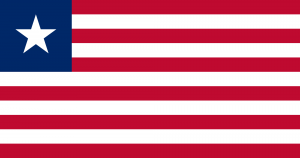 |
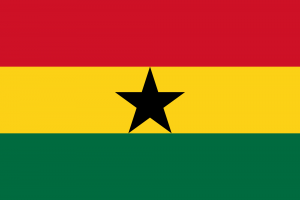 |
 |
 |
| Liberia | Ghana | South Africa | Canada |
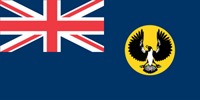 |
 |
 |
 |
| Air Freight Charter Adelaide | Air Freight Charter Canberra | Air Freight Charter Hobart | Air Freight Charter Darwin |
Thank-you for contacting us, it’s great that you have selected our contact us page, we appreciate the opportunity, if your shipment relates to air freight or less than a container load sea freight, please include the weight and dimensions of each piece in your request. We look forward to working with you, please feel free to call at any time.
TEL: 1300 767 136






